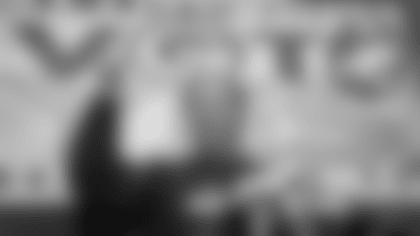Dave from Waukesha, WI
Were the Packers ever named or called the Green Bay Blues?
"Blues" was never a nickname, much less an official one. But more than 100 years ago, in 1922, Green Bay's entry in the National Football League attempted to abandon the nickname "Packers," when it was trying to eliminate any reminder of Acme Packing's involvement with the team. A Chicago-based company, Acme was $3.65 million in debt – or more than $63 million in today's money – by the end of the 1921 football season. And more than likely, many Green Bay residents at the time were taken for a financial bath in the process.
On Aug. 27, 1921, the minutes of an American Professional Football Association (now the NFL) meeting held in Chicago read: "Motion made, seconded and carried that Acme Packers of Green Bay, Wisconsin be admitted to membership." A little more than two months later, on Oct. 30, one week after the Packers had played their first APFA game, "The Dope Sheet: Official Program and Publication, Acme-Packers Football Team," declared that Acme Packing "does not own nor financially back the Packer team." The Dope Sheet's "Editorial Note" stated that Acme had equipped the team and purchased uniforms "bearing their names" but no longer had an interest in the team.
Acme's purchase or consolidation with Indian Packing, the Packers' original sponsor in their independent seasons of 1919 and '20, had been finalized in mid-January 1921. A month later, Acme Packing stock was sold for the first time on the New York Curb Market for $5 a share. On May 3, 1921, less than three months later, it sold for a record-low $2. On August 27, the day the APFA granted Green Bay a franchise in Acme's name, the stock sold for 75 cents. By October – the Packers played their first APFA game on Oct. 23 – representatives of banks in New York and Chicago had arrived in Green Bay and taken control of Acme's financial affairs.
Simple math reveals that early local investors in Indian Packing, which had closed at $44 on its first day of trading on the "Curb" market in 1919, and even new Acme shareholders had lost money and perhaps substantial sums of it in some cases. Furthermore, "The Dope Sheet" story suggested that there were Packers fans who were upset because they believed Acme "was running the team purely as an advertisement and was prepared to lose any amount of money on it."
To make matters worse, in their 1921 season finale against the Racine Legion, a non-league opponent, the Packers used at least three University of Notre Dame players – with athletic eligibility remaining – under assumed names and were booted out of the APFA in late January 1922, as a result.
Led by Curly Lambeau and newspaperman George Calhoun, the Packers' cofounders in 1919, the team reorganized over the next few months as a private corporation named the Green Bay Football Club and was readmitted to what soon would be renamed the NFL in late June 1922. Lambeau was president of the corporation; Joe Ordens, vice president; Nate Abrams, treasurer; and Calhoun, secretary.
With Acme dying a slow death in a small office in Green Bay as creditors tried futilely to reorganize the company, the Green Bay Football Club wanted to distance itself from the packing plant. Thus, at the top of its stationery, under the title, "Green Bay Football Club," it added a line in smaller type that read: "(Formerly Packers)."
Meanwhile, Calhoun was again covering the team for the Green Bay Press-Gazette, while also serving as a corporate officer of the Green Bay Football Club, and trying his best to avoid using the name Packers in his stories.

At the same time, the new subtitle for "The Dope Sheet" was "Official Program and Publication, Green Bay Professional Football Club" with Earl "Curley"(sic) Lambeau listed as Captain.
The Oct. 8, 1922, issue (with the year misprinted as 1921) was published on the day of Green Bay's home opener and the lead to a front-page story began: "The Big 'Blues' first appearance at home this year is with the Racine American Legion team…" There also were references in that edition to "Bays" and "big blue Bays." However, in the Nov. 5, 1922 "Dope Sheet," I found no mention of the "Blues" or "Big Bay Blues."
At that point, it certainly appeared that those nicknames had a short shelf life. What's more, I didn't find any references to them that year in the Press-Gazette or the Milwaukee papers.
In his Press-Gazette stories, Calhoun mostly referred to the team simply as the "Bays." Other references that he used were "the Green Bay Football club," "the Bay eleven," "the Green Bay eleven," "the Green Bay football team," "Green Bay's pro footballers," "Green Bay's pigskin aggregation," and the list could go on.
In scanning the Press-Gazette's stories that year, the closest name I found to "Blues" was a single reference to Green Bay's "Big Blue Team" on Sept. 18, 1922. Otherwise, the paper used the nickname Packers, despite its efforts to avoid doing so, more than any variation of "Blues."
In contrast, most other newspapers in Milwaukee, elsewhere in Wisconsin, and in other NFL cities at the time, including Chicago, Buffalo, Minneapolis, Rock Island, Dayton, Evansville and Rochester, N.Y., continued to refer to Green Bay's team as the Packers.
The Green Bay Football Club was underfunded and proved to be another financial disaster. Consequently, the NFL wasted no time reassigning the franchise in January 1923 to the proposed Green Bay Football Corporation, which was still more than seven months away from being chartered by the State of Wisconsin. That public corporation, the parameters of which remain in place today, was completed in mid-September 1923 and almost immediately, the Press-Gazette and the team resumed using the nickname "Packers."
However, it was late that season when the name "Big Bay Blues" was truly coined and then frequently used through the 1920s by the Press-Gazette and others as an alternative, or secondary, nickname to the Packers. It was more a term of endearment than anything else. And Calhoun continued to occasionally use it in his historical columns until only months before his death in 1963.
One could maybe argue that "Bays" was an unofficial nickname in 1923 because of its frequent use by the Press-Gazette. But I'd compare "Bays" more to the Montreal Canadiens' colloquial nickname, the Habs, except that "Bays" didn't stand the test of time.
As for "Big Bay Blues," I'd compare the use of that nickname to the "Bronx Bombers," except, again, it hasn't held up over time.

Jeff from Oceanside, CA
Why does the Pro Football Hall of Fame insist on continuing to perpetrate the falsehood that Vince Lombardi said Forrest Gregg was the finest player he ever coached? The video they recently posted on their Facebook page about Gregg includes that erroneous claim and is an insult to both Lombardi and Paul Hornung. Your documentation clearly refutes it, as you so meticulously explained in your article, "It's Time Canton Got It Right." Why won't the HOF listen?
How often do you hear people admit to mistakes? But you've correctly summarized the damage that was done by the Pro Football Hall of Fame's and NFL Films' dissemination of a fabricated quote that came from and was written by totally unreliable sources and accepted as fact by many for almost 50 years. At this point, trying to correct their mistake is a chore much like putting toothpaste back in the tube. What's most unfortunate is that even former NFL coaches and general managers who would go ballistic if they were similarly misquoted bought into this falsehood hook, line and sinker, and undoubtedly were influenced over the years by it when selecting all-time teams and dishing out other post-career honors with other great Packers of that era being the victims.
But there is hope. The Pro Football Hall of Fame has removed the quote from Gregg's bio at its website.
Mike from Lena, WI
I read a book on Bart Starr recently. His Packer No. 15 has been retired. But I found it interesting that when he reported to the Packers, he was issued No. 42. Also, in college he played defensive back and was a pretty good punter. All true?
Sure is. Starr was assigned No. 42 when he reported for rookie camp in Green Bay in mid-July 1956, but I don't know why other than that No. 15 belonged to Paul Held, who had served as Tobin Rote's backup for the final five games in 1955 after being cut in training camp by Detroit. In fact, Starr wore No. 10 at Alabama.
As it turned out, on individual picture day in late July of Starr's rookie year, both he and Held wore No. 15. And when the Packers played their first intra-squad game on Aug. 4, 1956, at Monterey Stadium in Janesville, Wis., Starr wore No. 16. Sometime after Held was cut on Sept. 10, Starr was given No. 15. But what's also puzzling about that is he was wearing 15 in the team photo published two days before the Packers' season opener, whereas in the program for that first game on Sept. 30, he was listed as No. 16.
Packers fan and collector Mark Schneider also tells me: "Story on Starr does not end there. Every intrasquad and preseason program has Bart in No. 16. First home game program, Bart is 16; 10-7 program vs. Bears, Bart is 15. However, all three Milwaukee programs have Bart as 16, including November game against the Cleveland Browns. A little less coordination and rapid information back then."
Starr's best season at Alabama was 1953, his sophomore year. He completed nearly 50 percent of his passes for 870 yards and eight touchdowns, averaged 41.4 yards as a punter and intercepted two passes. That was during the one-platoon era of college football when the substitution rules forced players to play both offense and defense. As a junior, Starr lost his starting job and as a senior the Crimson Tide finished 0-10.
Here's a trivia question: Name the top two punters in college football in 1953? Here's a hint: They both punted in the Southeastern Conference. Answer? Zeke Bratkowski of Georgia was No. 1 with a 42.6 average followed by Starr.
Here's another interesting tidbit. When Starr played in the old Blue-Gray all-star game following his senior season, he started at safety, but not quarterback. The South's starter at quarterback was Bob Hardy of Kentucky.
In Green Bay, Starr was one of five quarterbacks on the roster at the start of training camp. The others beside seven-year veteran and entrenched starter Rote were Held, who had played in eight games for Pittsburgh in 1954 and in two for the Packers in '55; Lynn Beightol, drafted in the 17th round as a future from Maryland in 1955; and Rod Hermes, their 30th and final-round selection in 1956 from Beloit College.

Lucas from Greensboro, NC
What can you tell me about Bill Lee? I find it interesting that he was on the NFL's 1930s All-Decade Team but is not a member of the Packers Hall of Fame.
Lee was a tackle who played for the Packers from mid-season 1937 through '42, and then again in '46. The Packers acquired Lee on Oct. 26, 1937, six games into an 11-game season, through a trade with the Brooklyn Dodgers. At first, the Packers announced that they had swapped rookie guard Francis "Zud" Schammel in exchange for Lee. However, three days later, they revealed they were sending rookie tackle Averell Daniell to the Dodgers instead of Schammel without offering an explanation.
Lee had played with Don Hutson at Alabama and had been offered a contract by Lambeau following the 1935 Rose Bowl, which was a year before the first NFL draft. But Lee signed with Brooklyn instead and played his first two-and-a-half seasons there.
Lee was one of five tackles selected to the NFL 1930s All-Decade Team, along with Pro Football Hall of Famers Joe Stydahar and Turk Edwards. Lee and the other two tackles, George Christensen of the Portsmouth Spartans/Detroit Lions and Frank Cope of the New York Giants, are not in the Hall of Fame. Curiously, Cope played most of his career in the 1940s. He played 20 games in 1938 and '39, his first two seasons, and 78 in the '40s.
But you've raised an obvious question. Why isn't Lee at least in the Packers Hall of Fame? After all, he played in 53 games for them over seven seasons.
To be honest, I can't answer your question. A few years ago, I compiled a short list of old-timers that I thought may have been overlooked in the voting and that list is distributed to the Packers Hall of Fame selection committee members each year. But without knowing more about Lee's career and why he was passed over, I've admittedly never pushed his candidacy and don't know if Lee will ever get serious consideration.
Perhaps it had something to do with him playing in only one game in 1942 before entering the Navy and then being credited with playing in only four games when he returned in '46. Plus, Lee played in only four games for the Packers in 1937 after being acquired in the trade with Brooklyn. Thus, he really played in only four full seasons for the Packers.
He also never made all-pro with the Packers after receiving a second-team nod on the Green Bay Press-Gazette selections as a rookie in 1935 with the Dodgers. Lee also was named second-team all-pro by the Chicago Daily News in 1936. As a result, one could speculate that there was some belief that he enjoyed his best years with the Dodgers.
Then again, Lee and Buckets Goldenberg were appointed the first season-long co-captains in Packers history 10 days before the 1942 opener. And when Lee returned in '46 after his service stint during World War II, Lambeau said, "Bill is one of the smartest and best tackles the National league ever had."















